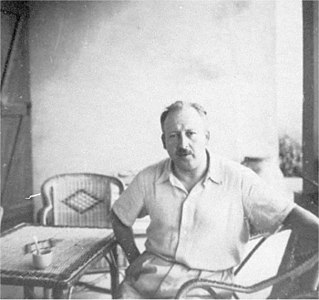
Jacques Marie Émile Lacan was a French psychoanalyst and psychiatrist. Described as "the most controversial psycho-analyst since Freud", Lacan gave yearly seminars in Paris, from 1953 to 1981, and published papers that were later collected in the book Écrits. Transcriptions of his seminars, given between 1954 and 1976, were also published. His work made a significant impact on continental philosophy and cultural theory in areas such as post-structuralism, critical theory, feminist theory and film theory, as well as on the practice of psychoanalysis itself.
Psychoanalysis is a set of theories and therapeutic techniques that deal in part with the unconscious mind, and which together form a method of treatment for mental disorders. The discipline was established in the early 1890s by Sigmund Freud, whose work stemmed partly from the clinical work of Josef Breuer and others. Freud developed and refined the theory and practice of psychoanalysis until his death in 1939. In an encyclopedic article, he identified the cornerstones of psychoanalysis as "the assumption that there are unconscious mental processes, the recognition of the theory of repression and resistance, the appreciation of the importance of sexuality and of the Oedipus complex." Freud's colleagues Alfred Adler and Carl Gustav Jung developed offshoots of psychoanalysis which they called individual psychology (Adler) and analytical psychology (Jung), although Freud himself wrote a number of criticisms of them and emphatically denied that they were forms of psychoanalysis. Psychoanalysis was later developed in different directions by neo-Freudian thinkers, such as Erich Fromm, Karen Horney, and Harry Stack Sullivan.
The International Psychoanalytical Association (IPA) is an association including 12,000 psychoanalysts as members and works with 70 constituent organizations. It was founded in 1910 by Sigmund Freud, from an idea proposed by Sándor Ferenczi.
The Berlin Psychoanalytic Institute was founded in 1920 to further the science of psychoanalysis in Berlin. Its founding members included Karl Abraham and Max Eitingon. The scientists at the institute furthered Sigmund Freud's work but also challenged many of his ideas.
The Société Française de Psychanalyse (SFP) was a French psychoanalytic professional body formed in 1953, in a split from the main body of French psychoanalysts, the Société Parisienne de Psychanalyse (SPP).
The École freudienne de Paris (EFP) was a French psychoanalytic professional body formed in 1964 by Jacques Lacan.It became 'a vital—if conflict-ridden—institution until its dissolution in 1980'.

Rudolph Maurice Loewenstein was an American psychoanalyst who practiced in Germany, France, and the United States.
Hermann/Herman Nunberg was a psychoanalyst and neurologist.

Élisabeth Roudinesco is a French scholar, historian and psychoanalyst. She conducts a seminar on the history of psychoanalysis at the École Normale Supérieure.

René Laforgue was a French psychiatrist and psychoanalyst.

Joan Hodgson Riviere was a British psychoanalyst, who was both an early translator of Freud into English and an influential writer on her own account.
The Paris Psychoanalytical Society (SPP) is the oldest psychoanalytical organisation in France. Founded with Freud’s endorsement in 1926, the S.P.P. is a component member of the International Psychoanalytical Association (I.P.A.) as well as of the European Psychoanalytical Federation (E.P.F.).
The Independent or Middle Group of British analysts represents one of the three distinct sub-schools of the British Psychoanalytical Society, and 'developed what is known as the British independent perspective, which argued that the primary motivation of the child is object-seeking rather than drive gratification'. The 'Independent group...is strongly associated with the concept of countertransference as well as with a seemingly pragmatic, anti-theoretical attitude to psychoanalysis'.
Ella Freeman Sharpe (1875–1947) was a leading figure in the early development of psychoanalysis in Britain, and was among the most influential of the first British training analysts.
Daniel Lagache was a French physician, psychoanalyst, and professor at the Sorbonne. He was born and died in Paris.
Serge Leclaire was a French psychiatrist and psychoanalyst. Initially analyzed by Jacques Lacan, he 'became the first French "Lacanian"'.

Max Eitingon was a German medical doctor and psychoanalyst, instrumental in establishing the institutional parameters of psychoanalytic education and training.
Angelo Louis Marie Hesnard was a French born psychiatrist and psychoanalyst, and was an important figure in 1930s French sexology.
The Pass is a procedure that was introduced by Jacques Lacan in 1967 as a means of gathering data on a psychoanalysis and investigating its results. It was adopted as an institutional procedure in the École freudienne de Paris and later in the World Association of Psychoanalysis.
Lacanianism or Lacanian psychoanalysis is a theoretical system that explains the mind, behaviour, and culture through a structuralist and post-structuralist extension of classical psychoanalysis, initiated by the work of Jacques Lacan from the 1950s to the 1980s. Lacanian perspectives contend that the human mind is structured by the world of language, known as the Symbolic. They stress the importance of desire, which is conceived of as perpetual and impossible to satisfy. Contemporary Lacanianism is characterised by a broad range of thought and extensive debate between Lacanians.






